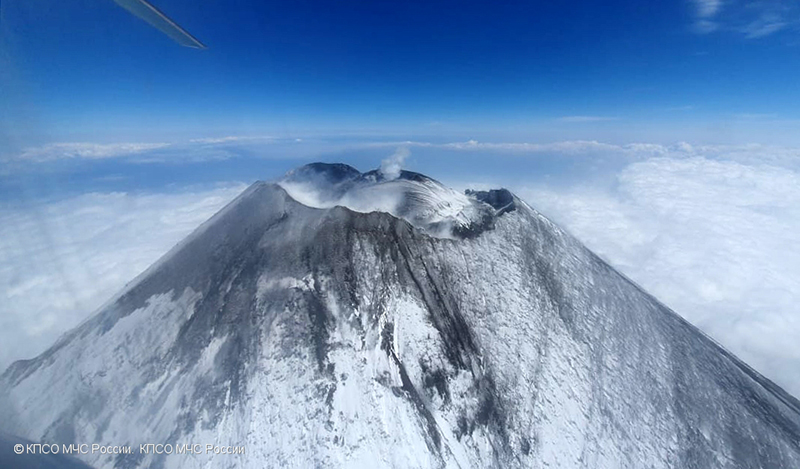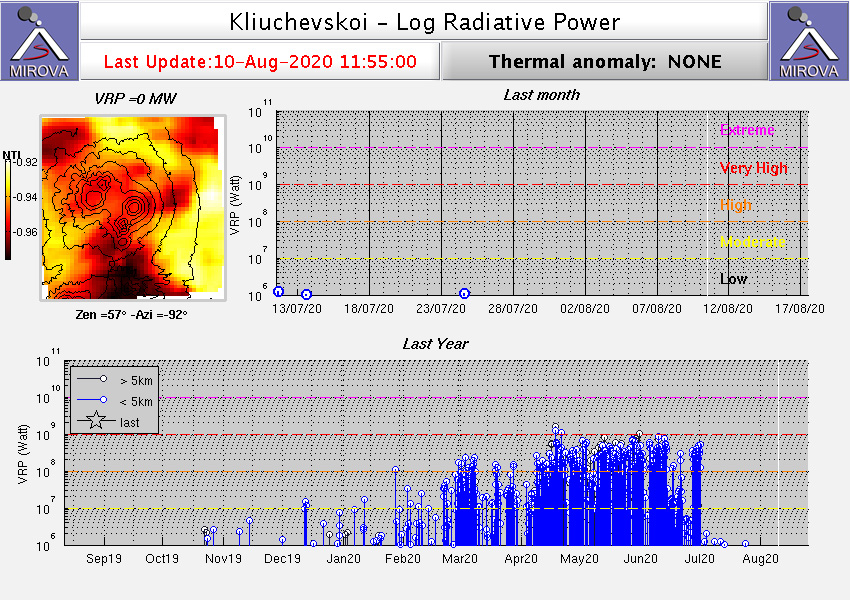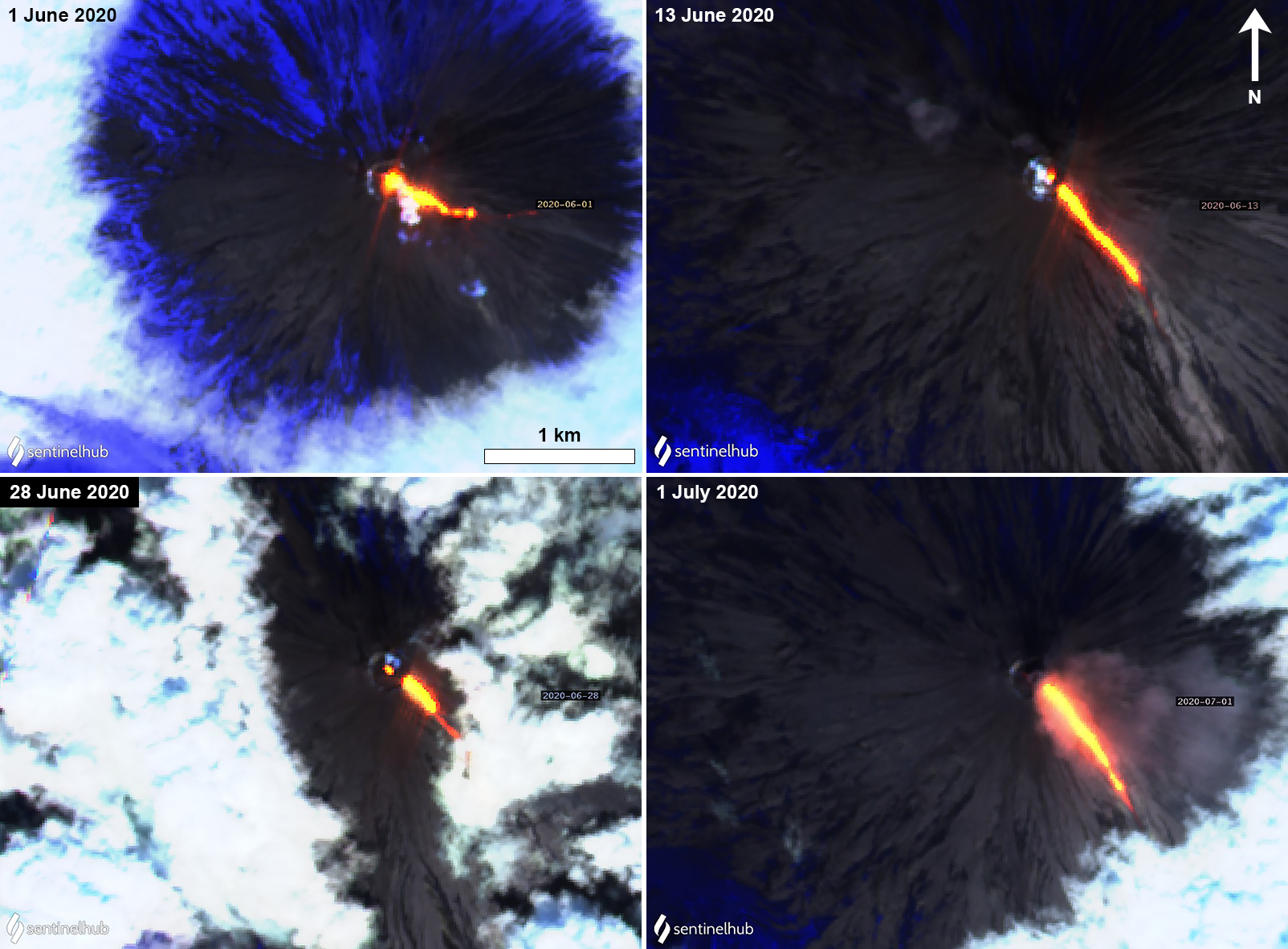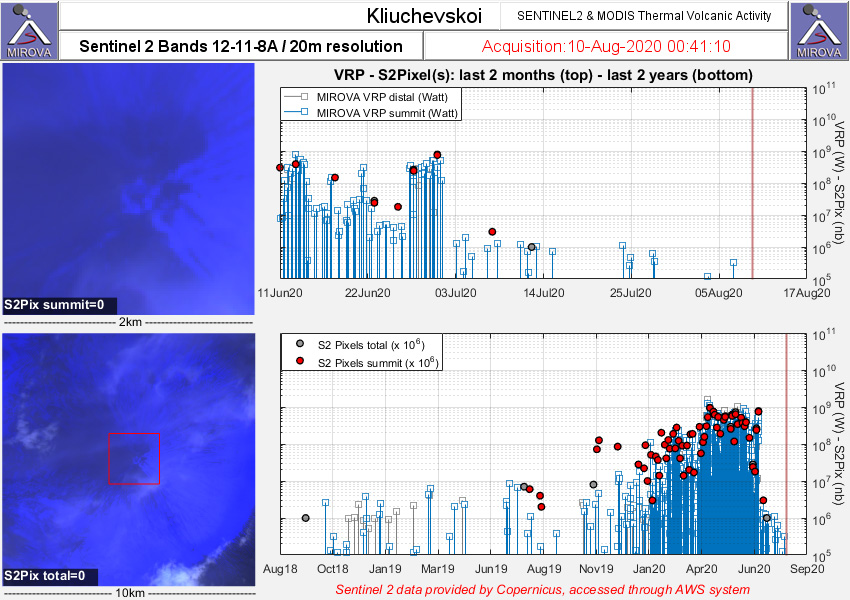Report on Klyuchevskoy (Russia) — September 2020
Bulletin of the Global Volcanism Network, vol. 45, no. 9 (September 2020)
Managing Editor: Edward Venzke.
Edited by Kadie L. Bennis.
Klyuchevskoy (Russia) Strombolian activity, gas-and-steam and ash plumes, and a lava flow during June-early July 2020
Please cite this report as:
Global Volcanism Program, 2020. Report on Klyuchevskoy (Russia) (Bennis, K.L., and Venzke, E., eds.). Bulletin of the Global Volcanism Network, 45:9. Smithsonian Institution. https://doi.org/10.5479/si.GVP.BGVN202009-300260
Klyuchevskoy
Russia
56.056°N, 160.642°E; summit elev. 4754 m
All times are local (unless otherwise noted)
Klyuchevskoy is a frequently active stratovolcano located in northern Kamchatka. Historical eruptions dating back 3,000 years have included more than 100 flank eruptions with most lateral craters and cones occurring along radial fissures between the unconfined NE-to-SE flanks. The previous report (BGVN 45:06) described ash plumes, nighttime incandescence, and Strombolian activity. Strombolian activity, ash plumes, and a strong lava flow continued. This report updates activity from June through August 2020 using weekly and daily reports from the Kamchatkan Volcanic Eruption Response Team (KVERT), the Tokyo Volcanic Ash Advisory (VAAC), and satellite data.
Moderate explosive-effusive activity continued in June 2020, with Strombolian explosions, frequent gas-and-steam emissions that contained some amount of ash, and an active lava flow. On 1 June a gas-and-steam plume containing some ash extended up to 465 km SE and E. The lava flow descended the SE flank down the Apakhonchich chute (figure 43). Occasionally, phreatic explosions accompanied the lava flow as it interacted with snow. Intermittent ash plumes, reported throughout the month by KVERT using video and satellite data and the Tokyo VAAC using HIMAWARI-8 imagery, rose to 5.5-6.7 km altitude and drifted in different directions up to 34 km from the volcano. On 12 and 30 June ash plumes rose to a maximum altitude of 6.7 km. On 19 June, 28-30 June, and 1-3 July some collapses were detected alongside the lava flow as it continued to advance down the SE flank.
During 1-3 July moderate Strombolian activity was observed, accompanied by gas-and-steam emissions containing ash and a continuous lava flow traveling down the Apakhonchich chute on the SE flank. On 1 July a Tokyo VAAC advisory reported an ash plume rising to 6 km altitude and extending SE. On 3 July the activity sharply decreased. KVERT reported there was some residual heat leftover from the lava flow and Strombolian activity that continued to cool through at least 13 July; KVERT also reported frequent gas-and-steam emissions, which contained a small amount of ash through 5 July, rising from the summit crater (figure 44). The weekly KVERT report on 16 July stated that the eruption had ended on 3 July 2020.
 |
Figure 44. Fumarolic activity continued in the summit crater of Klyuchevskoy on 7 July 2020. Courtesy of KSRS ME, Russia, KVERT. |
MIROVA (Middle InfraRed Observation of Volcanic Activity) analysis of MODIS satellite data shows frequent and strong thermal activity within 5 km of the summit crater from March through June followed by a sharp and sudden decline in early July (figures 45). A total of six weak thermal anomalies were detected between July and August. According to the MODVOLC thermal algorithm, a total of 111 thermal alerts were detected at or near the summit crater from 1 June to 1 July, a majority of which were due to the active lava flow on the SE flank and Strombolian explosions in the crater. Sentinel-2 thermal satellite imagery frequently showed the active lava flow descending the SE flank as a strong thermal anomaly, sometimes even through weather clouds (figure 46). These thermal anomalies were also recorded by the Sentinel-2 MODIS Thermal Volcanic Activity data on a MIROVA graph, showing a strong cluster during June to early July, followed by a sharp decrease and then a hiatus in activity (figure 47).
Geological Summary. Klyuchevskoy (also spelled Kliuchevskoi) is Kamchatka's highest and most active volcano. Since its origin about 6000 years ago, the beautifully symmetrical, 4835-m-high basaltic stratovolcano has produced frequent moderate-volume explosive and effusive eruptions without major periods of inactivity. It rises above a saddle NE of sharp-peaked Kamen volcano and lies SE of the broad Ushkovsky massif. More than 100 flank eruptions have occurred during the past roughly 3000 years, with most lateral craters and cones occurring along radial fissures between the unconfined NE-to-SE flanks of the conical volcano between 500 m and 3600 m elevation. The morphology of the 700-m-wide summit crater has been frequently modified by historical eruptions, which have been recorded since the late-17th century. Historical eruptions have originated primarily from the summit crater, but have also included numerous major explosive and effusive eruptions from flank craters.
Information Contacts: Kamchatka Volcanic Eruptions Response Team (KVERT), Far Eastern Branch, Russian Academy of Sciences, 9 Piip Blvd., Petropavlovsk-Kamchatsky, 683006, Russia (URL: http://www.kscnet.ru/ivs/kvert/); Tokyo Volcanic Ash Advisory Center (VAAC), 1-3-4 Otemachi, Chiyoda-ku, Tokyo 100-8122, Japan (URL: http://ds.data.jma.go.jp/svd/vaac/data/); Hawai'i Institute of Geophysics and Planetology (HIGP) - MODVOLC Thermal Alerts System, School of Ocean and Earth Science and Technology (SOEST), Univ. of Hawai'i, 2525 Correa Road, Honolulu, HI 96822, USA (URL: http://modis.higp.hawaii.edu/); MIROVA (Middle InfraRed Observation of Volcanic Activity), a collaborative project between the Universities of Turin and Florence (Italy) supported by the Centre for Volcanic Risk of the Italian Civil Protection Department (URL: http://www.mirovaweb.it/); Sentinel Hub Playground (URL: https://www.sentinel-hub.com/explore/sentinel-playground).





